The education industry is experiencing a crisis: schools have limited resources, and overwhelmed teachers struggle to meet students’ diverse learning needs. AI-powered language tutors can assist in overcoming these challenges by personalizing the learning experience and providing learning support 24/7.
By developing an AI language tutor, your business can offer valuable tools to educational organizations or end-users, helping teachers perform their tasks more effectively and transforming how students approach language learning.
This article will be valuable for experts in the education sector who are considering building a language tutoring solution using AI as its core technology. We explore how AI can enhance language education and provide a practical example of building an AI language tutor. You will also discover AI’s potential for transforming traditional learning methods and what to consider before implementing AI in your eLearning solution.
Tasks and benefits of AI language tutors
What is an AI language tutor?
An AI language tutor is software that fills the role of a human tutor. Just like human tutors, AI tutors provide one-on-one instructions, give feedback, and cater to students based on their individual abilities and preferences.
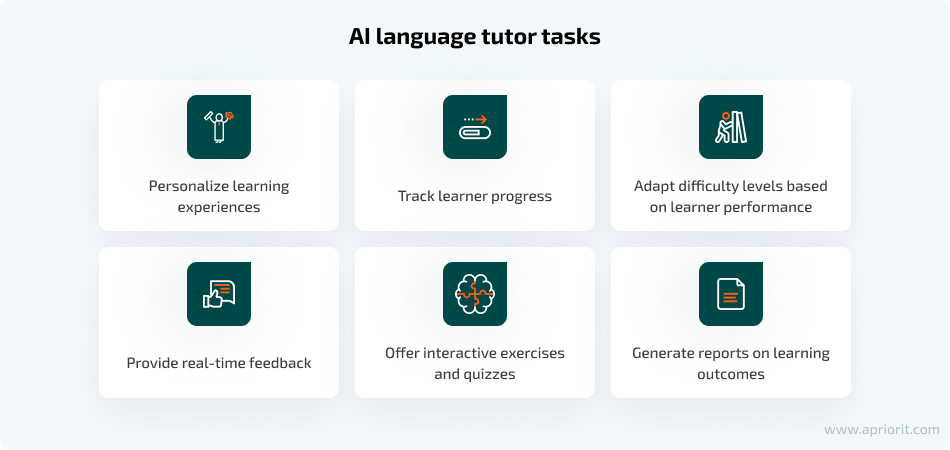
What benefits do AI language tutors bring?
Thanks to AI, digital language tutors can provide unique advantages compared to human teachers and traditional teaching methods. They include:
- Personalization. AI tutors analyze data from learner interactions to accurately identify knowledge gaps and tailor activities and the pace of learning to address them. This allows AI tutors to choose a specific approach for each student and enhance the learning experience.
- Automated feedback. With AI tutors, students don’t need to wait for the next session to get feedback on their progress. Students can get feedback immediately after a conversation with the tutor, helping them understand and learn from mistakes in real time.
- High engagement. AI language tutors can offer interactive and engaging content on the fly, such as additional exercises or quizzes. This will keep users motivated and interested in their studies.
- 24/7 availability. AI language tutors are accessible anytime, allowing users to learn at their own pace and on their own schedule. This flexibility is particularly beneficial for users with irregular schedules.
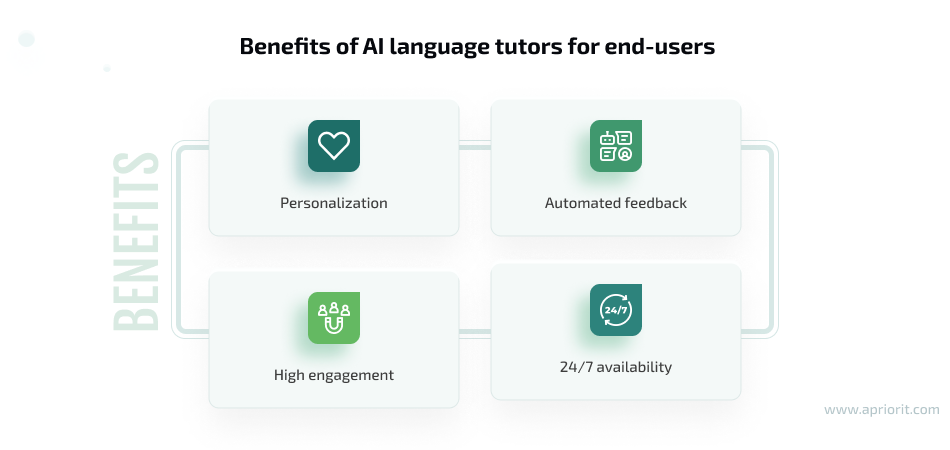
How do AI language tutors work?
AI language tutors use various technologies to detect and process natural language and perform tasks like checking spelling, translating, and providing feedback:
- Large language models (LLMs) process human language, enabling the system to perform complex language-related tasks.
- Natural language processing (NLP) allows your software to analyze, interpret, and respond to human language meaningfully.
- Speech recognition converts spoken language into text, enabling your solution to interact with users via voice and accurately transcribe speech.
- Machine learning (ML) trains your algorithms on large datasets, allowing it to improve its understanding and generation of language over time.
- Text-to-speech (TTS) and speech synthesis enable your software to produce spoken responses, making the user experience more natural and interactive.
To leverage all these technologies, developers must train an AI model on a large amount of data, usually in the form of vectors representing properties of language like words, meaning, or context. This will help an AI tutor identify similarities in data, recognize patterns, and provide relevant responses.
With basic knowledge of how AI language tutors work, let’s explore how you can leverage this technology to benefit your business.
Ready to harness the power of AI?
Create an impactful AI solution for your users and win over the market! Outsource your software development to Apriorit’s experienced engineers.
Why develop an AI language tutor solution?
Traditional online learning faces challenges, including a lack of teachers and limits on the number of students they can take on. That’s why AI is rapidly entering the education scene: in 2021, the global AI in education market was valued at $1.82 billion, and it is expected to grow at a CAGR of 36.0% from 2022 to 2030.
By leveraging AI, you can overcome the limitations of traditional educational platforms and bring an impressive, cost-efficient solution to a hot market. Let’s look at the benefits you can expect when building an AI tutor for language learning for educational organizations, schools, or end-users.

- High scalability and reach. AI language tutors can easily be scaled to accommodate a large user base without additional costs. This will allow you to reach more customers, including individual learners, educational institutions, and corporate clients, without dealing with the limitations of traditional or online classrooms with human teachers.
- Recurring revenue. You can offer an AI-powered language tutor as a subscription-based service to get a steady stream of recurring revenue. Different subscription models or levels will allow you to reach a wider audience with different educational needs and budgets.
- Continuous improvement. AI systems can learn on their own from feedback and user interactions. Thanks to this, your AI system can become more effective over time — all you need to do is regularly fine-tune it for the best results.
- Competitive advantage. Creating an advanced AI language tutor that can communicate with learners via speech can help you attract more users and outpace the competition.
If you plan to build an AI language tutor for internal use — for example, for your own online language school or a business organization — you can additionally benefit from:
- High customization. Unlike off-the-shelf solutions, a custom AI language tutor can be tailored to your business’s specific requirements, especially if you operate in niche markets or have strict regulatory requirements.
- Cost-efficiency. While the initial investment in developing a custom AI tutor may be high, businesses can save significantly in the long run by reducing expenses associated with hiring instructors, providing physical classrooms, and scaling training programs. Additionally, you can deploy automated learning solutions to a larger audience without additional costs.
- Data-driven insights. Leveraging data collected from AI language tutors allows businesses to gain valuable insights into employee or student performance, identify common challenges, and optimize training strategies. Thus, you can make your solution more efficient and improve overall training for your users.
Now that we’ve explored the benefits of building an AI language tutor, let’s examine the development process through a simple, practical example.
Read also
How to Build a Context-Aware AI Chatbot: Development Challenges and Solutions from Apriorit Experts
Win your customers with a truly smart chatbot! Learn how to create a context-aware chatbot that reflects your brand’s identity and brings your customer service to a new level.

Practical example of AI tutor development
Depending on your AI language tutor’s purpose and target audience, it may have different features and functionality. However, all such solutions have similar logic and work according to the same principles. As an example of how to create an AI language tutor, let’s build a simple solution that performs the following basic tasks:
- Communicates in a chosen language
- Analyzes mistakes made in dialogue
- Provides a detailed explanation of each mistake
As a result, the interaction of this AI language tutor with the learner will look like this:
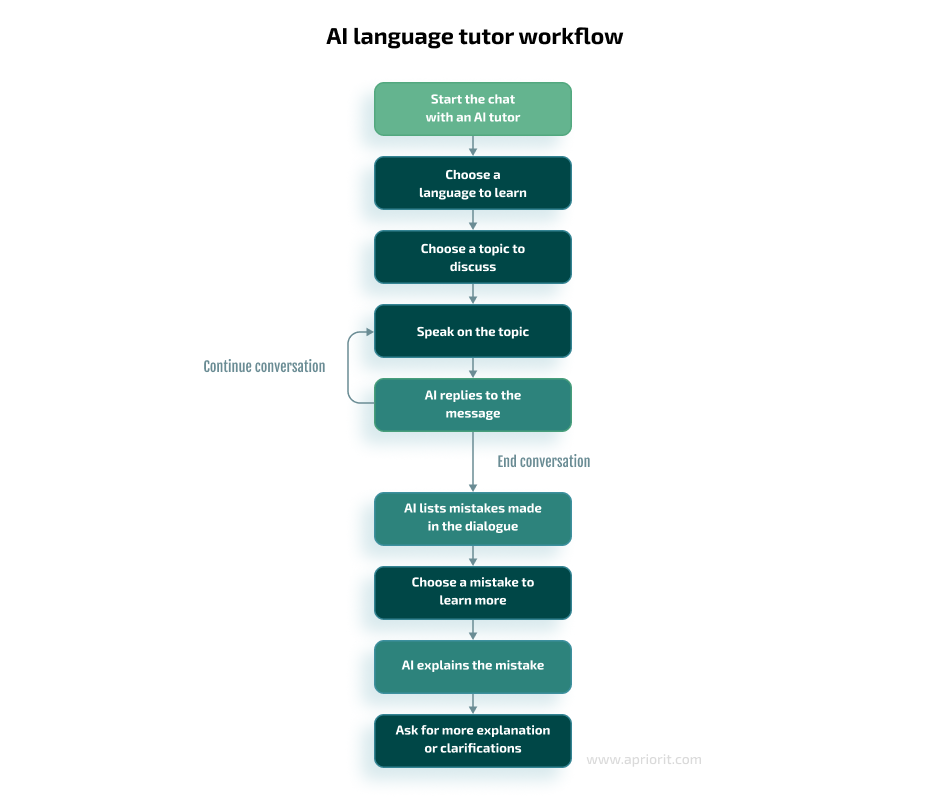
Because our application has to complete different tasks, let’s develop a designated module for each of them based on the following models:
- Whisper is a multilingual speech recognition model for accurately transcribing spoken language into text, supporting a wide range of languages and dialects.
- Cohere is a multi-language chat model designed to facilitate natural language conversations, enabling the AI tutor to engage in meaningful dialogues with users.
- Llama2 is an open-source model from Meta used to analyze language mistakes and identify grammatical and contextual inaccuracies in user inputs.
- GPT 3.5 is an LLM by OpenAI that provides detailed explanations of mistakes detected by Llama2.
To use these models in code, we use Python and the LangChain library, which provide a convenient interface for interacting with the LLMs. With the technology set carefully selected, let’s discuss how to create an AI tutor step by step:
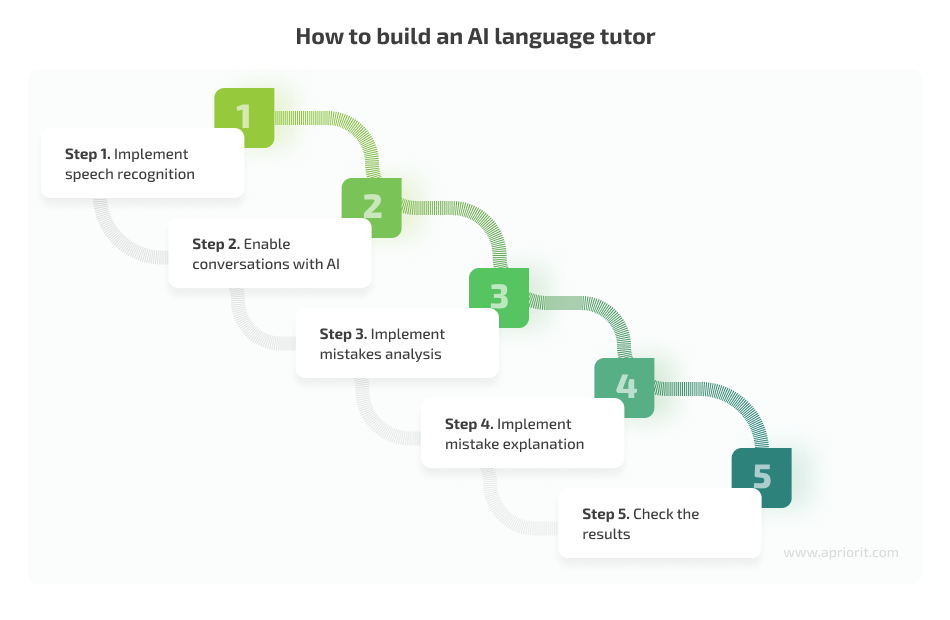
Step 1. Implement speech recognition
To communicate efficiently with students, our AI tutor has to analyze spoken language by recording audio and transcribing it into text. For these tasks, we’ll apply the SpeechRecognition library, which uses the local Whisper AI model, via a simple call. We’ll use the default multilanguage-based model to transcribe the audio in the given language.
import speech_recognition as sr
class SpeechToText:
def __init__(self):
self.recorder = sr.Recognizer()
self.microphone = sr.Microphone()
def record_and_recognize(self, language):
with self.microphone as source:
self.recorder.adjust_for_ambient_noise(source)
audio = self.recorder.listen(source)
transcription = self.recorder.recognize_whisper(
audio_data=audio,
language=language
)
return transcriptionThis code will return a string of transcribed text that other models will use next to process the text and generate responses.
Step 2. Enable conversations with AI
We’ll use the Cohere multilanguage model to allow students to have a natural conversation with AI on a given topic. First, we need to import settings from our project’s langtutor.config module and LangChain classes from the LangChain library, which will help us to create a prompt and interact with the AI.
from langtutor.config import get_settings
from langchain.llms import Cohere
from langchain.chains import ConversationChain
from langchain.memory import ConversationSummaryBufferMemory
from langchain.prompts.prompt import PromptTemplateThe next step is to design an effective prompt that will direct the AI to engage the user in a conversation and guide it by asking appropriate questions. The prompt should also contain a conversation summary so the AI can ask precise questions based on the context.
PROMPT_TEMPLATE = """The following is a friendly conversation between a human and an AI in {language}. The AI asks a QUESTION about {topic} based on conversation history. Remember to generate only one message.
Current conversation:
AI: {initial_question}
{{history}}
Human: {{input}}
AI:"""To use Cohere, we need to specify the model type and pass an API key to access this model.
class CohereChat:
def __init__(self, language, topic):
api_key = get_settings().cohere_key
llm = Cohere(model="command", cohere_api_key=api_key)We’ll keep the conversation summary in a memory buffer, with a limit of 100 tokens to not overload the LLM. For this, we’ll use a ConversationSummaryBufferMemory component from the LangChain library.
memory = ConversationSummaryBufferMemory(
llm=self.llm,
max_token_limit=100
)The AI will choose the initial question for the conversation from the preset we made based on the language and the conversation topic. All these parameters will be used to build a prompt from the template.
initial_question = get_initial_question(language, topic)
template = PROMPT_TEMPLATE.format(
language=language,
topic=topic,
initial_question=initial_question
)
prompt = PromptTemplate(
input_variables=["history", "input"],
template=template
)Finally, we create a ConversationChain with our LLM, memory buffer, and prompt.
self.conversation = ConversationChain(
llm=llm,
memory=memory,
prompt=prompt
)Messages to the AI are sent using a predict method that accepts text input. We’ll use the text transcribed by the Whisper model.
def send_msg(self, msg):
return self.conversation.predict(input=msg)Now, our users can converse with the AI using normal speech instead of text. The next step is to implement a tutoring element.
Read also
Starting a New AI Project: 12 Questions to Assess If You’re Ready
Become confident in your AI journey. Learn how to assess your need for AI, prepare for its adoption, and ensure your AI project is sustainable and profitable in the long run.
Step 3. Implement mistake analysis
To analyze users’ mistakes, we’ll use the Llama2 model with 13 billion parameters, which we pre-trained on a few examples to perform the task better.
The prompt for this model will ask the AI to prepare a list of mistakes for the given sentence. We’ll also highlight that only the list should be returned because we don’t need a human-readable explanation. Here is what our prompt looks like:
from langchain.llms import LlamaCpp
from langchain import PromptTemplate
template = """Question: List mistakes in this sentence: "{sentence}". Return ONLY the list with the categories of mistakes, without additional explanation.
Answer: """
prompt_template = PromptTemplate(template=template, input_variables=["sentence"])The example will use a local model that is running on the GPU. The output will be formatted as a list using the list.gbnf grammar pattern.
class LlamaCppAI:
def __init__(self):
self.llm = LlamaCpp(
model_path="./models/llama2-13b-trained.bin",
n_gpu_layers=1,
n_batch=512,
f16_kv=True,
grammar_path="./grammars/list.gbnf"
)To use the model, we need to format a prompt and then pass it to the LLM.
def get_mistakes_list(self, sentence):
prompt = prompt_template.format(sentence=sentence)
return self.llm(prompt=prompt)The result will look like this:
“[‘Subject-Verb Agreement’, ‘Tense’]”It can be used to gather statistics or formatted in a message for the user showing in which areas they made mistakes.
Step 4. Implement mistake explanations
To provide explanations of users’ mistakes, we’ll use the OpenAI GPT 3.5 model. In the prompt, we ask AI to behave as a language tutor and explain the problem:
def get_prompt_template():
system_template = "You are a {Language} language tutor. You are explaining '{problem}' in detail."
system_message_prompt = smpt.from_template(system_template)
human_template = "{request}"
human_message_prompt = hmpt.from_template(human_template)
return ChatPromptTemplate.from_messages(
[system_message_prompt, human_message_prompt]
)To initialize the model, we need an API key, which is retrieved from the application’s configuration settings, and the name of the model being used; in our case, it’s gpt-3.5-turbo.
from langtutor.config import get_settings
from langchain.prompts.chat import (
ChatPromptTemplate,
SystemMessagePromptTemplate as smpt,
HumanMessagePromptTemplate as hmpt,
)
from langchain.chat_models import ChatOpenAI
class OpenAITutor:
def __init__(self):
api_key = get_settings().openai_key
self.chat = ChatOpenAI(
openai_api_key=api_key,
model="gpt-3.5-turbo"
)
self.prompt_template = get_prompt_template()To obtain an explanation, we pass specific parameters to the prompt and return the AI’s response content.
def get_explanation(self, language, problem, request):
formatted_prompt = self.prompt_template.format_prompt(
language=language, problem=problem, request=request
).to_messages()
return self.chat(formatted_prompt).contentNow that all the models for our AI language tutor are configured, let’s check if it works as intended.
Step 5. Checking the results
To see how our solution works, we’ll have a conversation in English about skiing and intentionally make some mistakes. For this example, we’ll limit the number of questions in the dialogue to three.
Note that in this example, the user will speak to the AI tutor and receive feedback in text format. However, it is possible to enable the AI to answer with voice using a text-to-speech module.
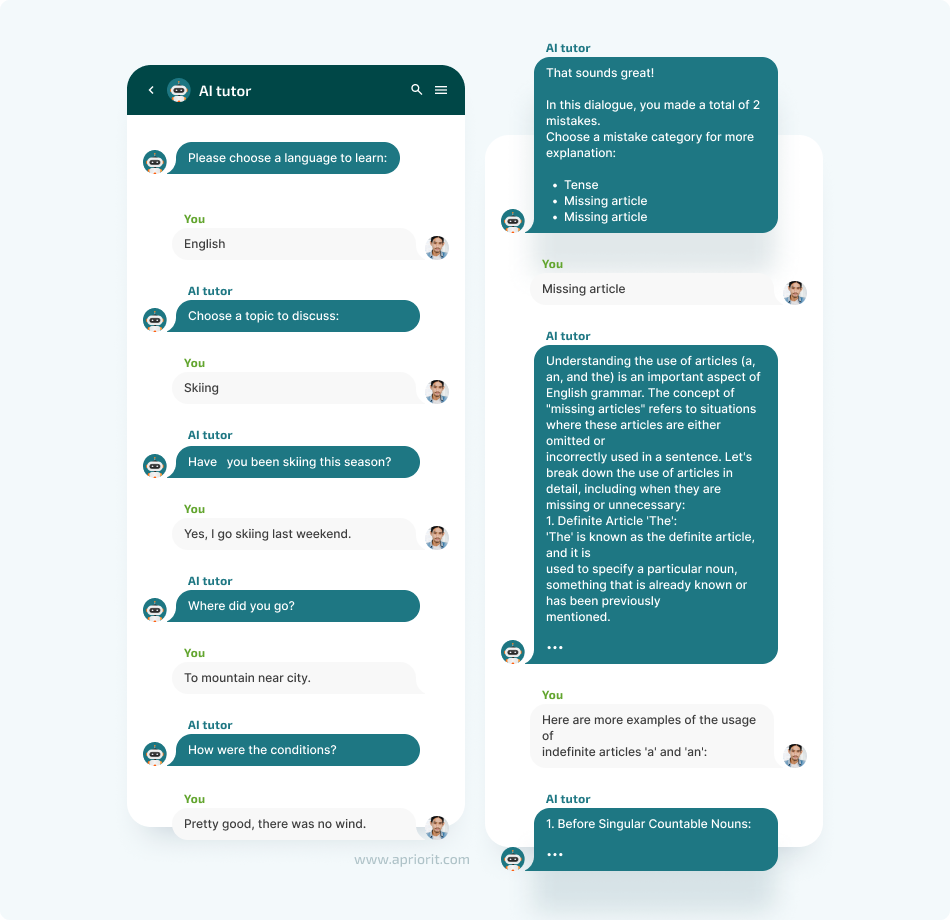
As you can see, the AI could find mistakes and explain grammar topics. Our AI tutor also understood additional questions and provided more examples.
Read also
Developing an AI-based Learning Management System: Benefits, Limitations, and Best Practices to Follow
Learn how AI can enhance your LMS, automate content management, and personalize training sessions to maximize your students’ results.

What to consider before building your AI language tutor
Although creating an AI language tutor is quite straightforward in our example above, it’s still a challenging process that requires your developers to consider multiple nuances and limitations. Let’s look at the challenges your team may face while developing an AI language tutor and how to solve them.

- NLP model’s accuracy and quality
An NLP model for an AI language tutor has to accurately understand and generate human language and handle diverse linguistic nuances, dialects, slang, and pronunciation. Developing such a solution from scratch requires significant resources, so most businesses opt for ready-made models like the one we used in the example above.
At Apriorit, we recommend this approach as well. Models like GPT-3.5, Whisper, or Cohere can be a strong foundation for your AI language tutor, helping you to save money and time on development. However, you still need to carefully choose a model and integrate it into your solution correctly.
- Fine-tuning with high-quality data
After choosing a model, you need to fine-tune it so it corresponds to the specific requirements of your AI language tutor application. Fine-tuning involves adjusting the model with additional training data relevant to your domain, user base, and specific tasks your tutor is expected to perform. This process helps the model better understand and respond to nuances like your users’ educational level, typical mistakes, and preferred style of explanations.
However, it can be challenging to collect comprehensive datasets covering diverse languages, dialects, and contexts. Even if you use a ready-made model, training these large models requires lots of computing as well as other resources as well as expertise.
We recommend using cloud-based platforms for scalable and efficient model training. To maintain and improve a model’s effectiveness, continuously monitor and refine the model based on real-world data.
- Security and privacy
AI language tutors often handle sensitive user data, including personal information, learning progress, interaction logs, and sometimes even spoken or written inputs that could reveal personal or confidential details.
If hackers breach your solution and access user data, you may face legal and regulatory consequences, including fines and penalties. Security issues can also lead to downtime, which might cause reputational damage.
To mitigate these risks and maintain user trust, you need to implement robust encryption methods for data storage and transmission. You should also ensure compliance with regulations depending on your location: for example, the GDPR if you plan to operate in Europe. To maintain your solution’s security, we recommend conducting regular security testing and vulnerability assessments.
- Maintenance and support
After your AI language tutor is up and running, it’s important to update and maintain it to keep it relevant and efficient. Maintenance includes addressing bugs, updating content, improving features, and regularly fine-tuning the model with new data.
At Apriorit, we recommend establishing a dedicated team responsible for regularly updating and monitoring your system. We also advise gathering user feedback and acting on reported inconsistencies with regular retraining, as language models can lose accuracy with time.
Related project
Building AI Text Processing Modules for a Content Management Platform
Learn how Apriorit introduced advanced AI features to our client’s content management platform and increased efficiency, competitiveness, and customer satisfaction.

How Apriorit can help you create an AI language tutor
At Apriorit, we have extensive experience developing sophisticated AI-based solutions for various educational and business applications. Our team of experts can help you select the most suitable technology, integrate it into your software, and handle a full range of AI-related tasks, including:
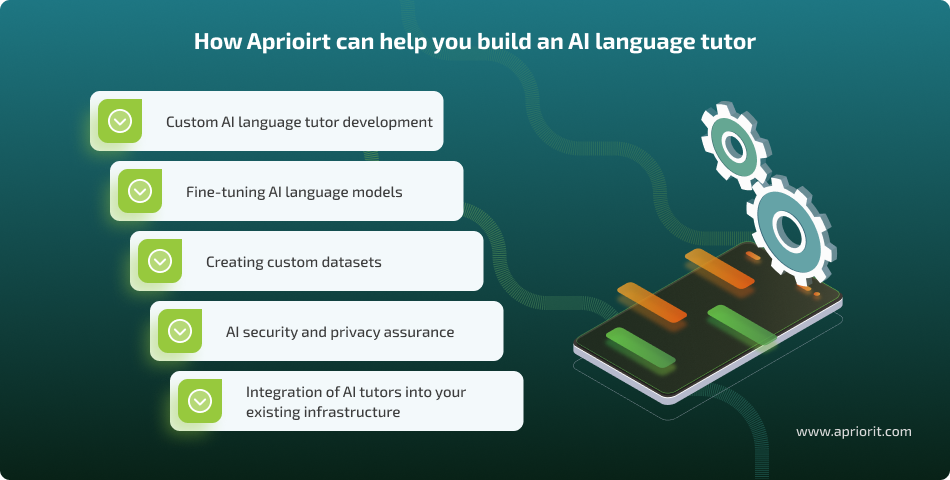
- Developing a custom AI language tutor. If you have unique specifications or must follow strict regulatory requirements, our engineers can create an AI language tutor from scratch. We can also leverage existing models, enhancing them with your data to meet your users’ educational goals.
- Fine-tuning AI language models. We can adapt pre-trained language models, such as GPT or Llama2, to align with your solution’s goals. Our team will ensure your AI tutor provides accurate, contextually appropriate, and valuable responses to your users.
- Creating custom datasets. Developing an effective AI language tutor often requires custom datasets tailored to specific educational tasks. If your organization has raw data that lacks structure and labeling, our team can help you organize and annotate it. We can also use generative AI to synthesize additional data, filling gaps and enhancing the model’s learning capabilities.
- AI security and privacy assurance. We conduct comprehensive security assessments to identify vulnerabilities and protect your AI language tutor from threats. Our services include adversarial testing, penetration testing, and vulnerability scans, ensuring your AI system is secure and complies with privacy requirements.
- Integrating AI language tutors into your existing infrastructure. If you already have an educational platform and want to expand its abilities with an AI language tutor, our AI development specialists can seamlessly integrate it. We ensure the integration is compatible, scalable, and interoperable with your current technologies.
With Apriorit, you’ll get end-to-end support in building AI language tutor solutions tailored to your needs. Whether you’re looking to implement existing models or develop custom solutions, we will prioritize security and privacy throughout the development process.
Conclusion
Building an AI language tutor can allow your educational business to offer accessible and personalized education to an unlimited number of people and expand your presence in the growing EdTech market.
To build a high-quality AI language tutor that provides accurate guidance to your users, you need to use technologies for speech recognition, language processing, and mistake analysis.
Apriorit’s AI development specialists are ready to help you choose and implement the perfect blend of AI technologies to create an efficient tutor for your target audience. Our experts take a security-first approach to building AI solutions so you can be sure your AI language tutor is reliable and secure.
Need an experienced team of AI engineers?
Get access to a pool of AI specialists who have delivered dozens of smart, secure, and efficient solutions to businesses in multiple domains!




